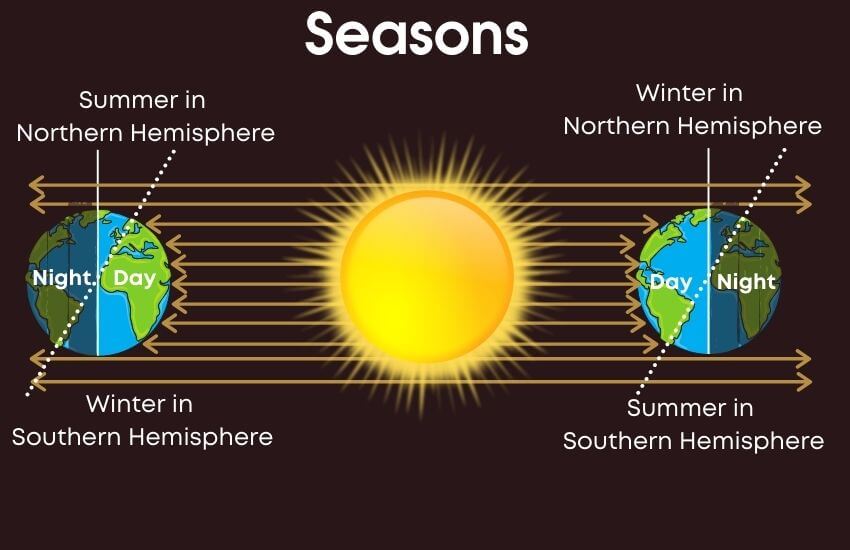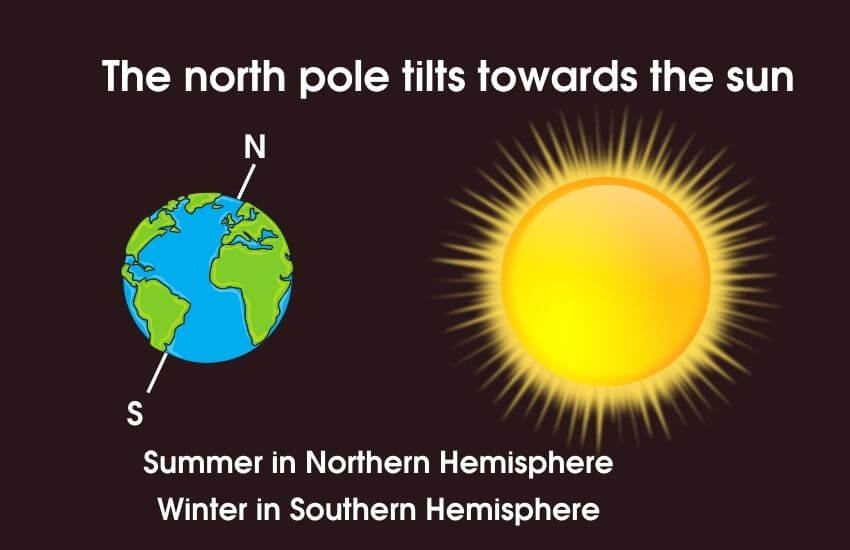Why We Have Seasons?
There are four seasons in many parts of the world; Spring, Summer, Fall and Winter but have you ever wondered why we have seasons? Let’s understand.
There are THREE reasons why we have seasons:
1. Tilted Earth: Earth has seasons because its axis is tilted. Due to this tilt, the North pole leans towards the sun for half the year and away from the sun for the rest.
2. Revolution: The Earth revolves around the sun.
3. The North Pole always points in the same direction.
What is an axis? Earth rotates around an imaginary line called an axis. It is tilted at an angle of 23.5 degrees.
Also Read: Earth Facts

And at the same time, it is opposite in the Southern Hemisphere when it is tilted away from the sun. It gets less intense sunlight for fewer hours of the day which makes the Southern Hemisphere cooler weather (i.e. Winter).
This results in the cycle of seasons.
The northern and southern hemispheres always have opposite seasons. If there is winter in the Northern Hemisphere then it would be summer in the Southern Hemisphere. That’s why when it is winter in the USA, it is summer in Australia.
Also Read: Layers of the Atmosphere


What is Solstice?
The word “Solstice” is derived from two Latin words, ‘sol’ means sun, and ‘sistere’ means to cause to stand still.
Solstices occur twice a year when the sun is at its greatest distance from the equator. In other words, the days that the Earth is most tilted toward the sun are called Solstices.
What is the Winter Solstice?
Did you know? In the southern hemisphere, the winter solstice falls in June but in the northern hemisphere, the winter solstice falls in December.
What is the Summer Solstice?
The summer solstice is also known as ‘Litha’ marks the first day of the summer season. It comes on around June 21. Summer solstice is the longest day of the year. The sun is highest in the sky on the summer solstice.
What are Equinoxes?
Spring Equinox
The spring equinox is called the Vernal Equinox. It is the first day of the spring season. Spring equinox is near March 20.
Fall Equinox
The fall equinox is called the Autumnal Equinox, and it marks the beginning of fall. Fall equinox is near September 22.
Did you know? Equinoxes do not always occur on the same day each year, and generally will occur about 6 hours later each year.

Amazing Facts About Seasons
FACT 1. June 21 is the longest, sunniest day of the year. This day is known as the Summer Solstice.
FACT 2. December 21 is the shortest, darkest day of the year. This day is known as the Winter Solstice.
FACT 3. Plants lose their leaves in autumn in response to decreasing length of the day.
FACT 4. In Australia, it is spring in the months of September, October and November. Summer is in the months of December, January and February. Autumn in the months of March, April and May. Winter in the months of June, July and August.
FACT 5. In St. Petersburg in Russia, the sky stays bright from mid June to mid July.This is called ‘White Nights.
FACT 6. The Arctic Circle only has two seasons: summer and winter. The sun only rises and sets once every year here.
FACT 7. On the Arctic Circle the night time is called the ‘Midnight Sun’, because the sun shines for 24hours a day during their 6 month summer.
FACT 8. In Svalbard, an island off Norway, the sun doesn’t set from April 19th until August 23rd, and the sun doesn’t rise from October 26th until February 15th.
FACT 9. Equinox do not always occur on the same day each year, and generally occur about SIX hours later each year, with a backward jump of a day on leap years.
FACT 10. The Earth is tilted at an angle of 23.5 degrees.
Hope you enjoyed the article “Why we have seasons”. Below are some reference sites name:
Why We Have Seasons Trivia
Which season has the longest daylight hours?
Summer
In which season do trees blossom?
Spring
What are the shortest and longest days called?
Solstices
How long does it take Earth to go around the sun?
One Year
What is it called when animals sleep through the winter?
Hibernation
When does summer happen in the southern hemisphere?
December to March
